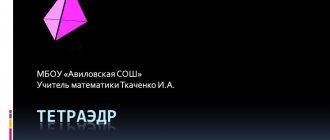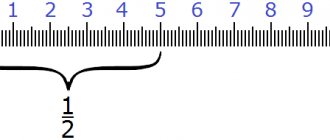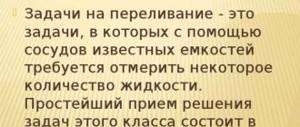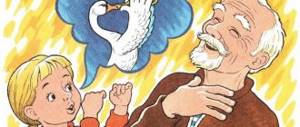Download material
so UNT / Lesson developments / Open lessons in mathematics
“Math Fair” is an open lesson in mathematics in the 4th grade. Topic "Actions with multi-digit numbers"
26.01.2014 10950 1528
Math Fair
lesson in 4th grade
Goals and objectives:
· Repetition, consolidation, generalization of the studied material
· Develop skills in solving problems of various types
· Learn to work independently
· Formation of ideas about the Russian fair and
initial ideas about different types of folk crafts
· Development of aesthetic taste in schoolchildren using examples of paintings.
· Expanding students' vocabulary and horizons.
Equipment:
1.
Projector, laptop with the presentation “Russian Fair” (reproductions of paintings by Russian artists).
2.
Recording of the song “ Ukhar the merchant was coming from the fair ”
3.
Handouts for students
4.
Carousel, matryoshka, samovar with bagels
The music “Ukhar the merchant was coming from the fair” sounds, the peddlers are calling
1. Wow! Oh you! Tara - rar! Everyone hurry to the market! Everyone hurry to the market! There is something here for everyone.
2. Like ours, containers - bars, All sorts of different goods! Buyers, go and take the goods from us!
3. Just to take our goods. You need to figure out the price! You need to figure out the price. You can’t take the goods without it!
4. There is a task with the product, If you decide - your luck! You will find out the price here and they will give you the goods!
5. If you make a mistake in the task, you will not receive any change, nor, moreover, the goods should have come to the market in vain!
6. Buyer, hurry up and go to the market! Run around - go to the shops. There are tasks on the counters.
Teacher:
Today we came to a fair, not a simple one, but a mathematical one.
There are a lot of different goods, buy them, don’t skimp. Show your ingenuity, intelligence, ability to count, quick thinking. Teacher:
Guys, what do you think a fair is? ( Children's statements. )
Teacher:
Let's try to find synonyms for the word fair in order to understand its meaning more broadly.
The following appears on the board: FAIR, TRADE, MARKET, BAZAAR.
Teacher:
In the old days they said this: “Where there are two, there is a market, three there is a bazaar, and seven there is a fair.”
How do you understand the meaning of this proverb? Presentation "Russian Fair"
1. Fair - a temporary, wide-open auction, which was held annually, at a certain time, in the same place. Artisans came here from different villages with their goods. The fair lasted from one day to several months. Slide 1
2. The fair usually hummed, made noise and was a crowd of people trading, buying various goods and people just walking. Slide 2
3. Fairs, in addition to their main function (places of trade), played an important role in the exchange of information, knowledge and experience of people. But many merchants sold their goods directly from carts or laying them out directly on the ground. Slide 3
4. Large transactions for the sale of bread and salt were made at the fair. Thanks to fairs, folk crafts flourished in Rus'. Slide 4-6
5. The fair offered a lot of entertainment: carousels, roller coasters. Of particular interest were booths, puppet theaters and traveling theaters. The buffoons entertained the audience. Sometimes merchants hired buffoons to dance and praise their goods. Slide 7
6. Great joy was brought by the folk pastime of climbing a pole. Prizes were hung high on a smooth, smooth pole. There were many who wanted to get a gift for themselves, but not everyone succeeded. Slide 8
Teacher:
I sell, I sell, I give away almost for nothing:
Equations, expressions, movement problems, thinking problems.
Colored envelopes with signatures hang on the carousel, students choose and complete the task
Envelope 1. Oral warm-up “Chest of Knowledge”
Teacher:
I buy any mathematical knowledge (every answer gets a money token)
Envelope 2. Find the meaning of the expression - work on options (2 students at the board)
5212036 – (28175 : 35 + 403 ∙
208)= 980081+ (341640 – 1263
∙
109)=
Envelope 3. Solving equations - with self-test (2 students at the board)
(showing cards 725 + x and 725 + x = 1000)
— Compare the recording data. What can you say about these expressions? The equation contains an unknown number and our goal is to find this unknown number.
4428 ∙
a = 50354 +7210 15
∙
(x +56) = 45060
Envelope 4. Musical physical exercise (projector, presentation)
Envelope 5. Solving problems (problems on cards (coloring on the reverse side - fair) - students choose a problem independently)
a)
On a dairy farm in one year, each of the 15 cows produced 5410 liters of milk and each of the 60 cows produced 5300 liters of milk.
From one third of all the milk they made butter and brought it to the fair. How much milk was used to make the butter? (task of finding a part of a whole number) b)
From two cities, the distance between which is 1116 km, two trains left at the same time towards each other to the fair.
The speed of the first train is 56 km/h, the speed of the second train is 68 km/h. How many hours later did they meet? (movement task) c)
The forge produced 16,250 horseshoes for the fair.
One blacksmith made 4450 horseshoes, the second made 5050 horseshoes, and the third made the rest. How many horseshoes did the third blacksmith make? (task of finding an unknown number using an equation) 6. Reflection. Grading.
A surprise moment - sweet cockerels from Matryoshka
Wow! Oh you! Tara - rar! If the problem had not been solved, then the market would end! Wouldn't buy the product. The market is over! If they didn't buy the product, they sold out all the product! It would be in vain to come to the market!
· To prepare for the lesson, Internet resources were used: poems; dance warm-up; reproductions of paintings by Russian artists
Application
| a) On a dairy farm in one year, each of the 15 cows produced 5410 liters of milk and each of the 60 cows produced 5300 liters of milk. From one third of all the milk they made butter and brought it to the fair. How much milk was used to make the butter? b) From two cities, the distance between which is 1116 km, two trains left simultaneously towards each other for the fair. The speed of the first train is 56 km/h, the speed of the second train is 68 km/h. How many hours later did they meet? c) The forge produced 16,250 horseshoes for the fair. One blacksmith made 4450 horseshoes, the second made 5050 horseshoes, and the third made the rest. How many horseshoes did the third blacksmith make? (using equation) | a) On a dairy farm in one year, each of the 15 cows produced 5410 liters of milk and each of the 60 cows produced 5300 liters of milk. From one third of all the milk they made butter and brought it to the fair. How much milk was used to make the butter? b) From two cities, the distance between which is 1116 km, two trains left simultaneously towards each other for the fair. The speed of the first train is 56 km/h, the speed of the second train is 68 km/h. How many hours later did they meet? c) The forge produced 16,250 horseshoes for the fair. One blacksmith made 4450 horseshoes, the second made 5050 horseshoes, and the third made the rest. How many horseshoes did the third blacksmith make? (using equation) |
| a) On a dairy farm in one year, each of the 15 cows produced 5410 liters of milk and each of the 60 cows produced 5300 liters of milk. From one third of all the milk they made butter and brought it to the fair. How much milk was used to make the butter? b) From two cities, the distance between which is 1116 km, two trains left simultaneously towards each other for the fair. The speed of the first train is 56 km/h, the speed of the second train is 68 km/h. How many hours later did they meet? c) The forge produced 16,250 horseshoes for the fair. One blacksmith made 4450 horseshoes, the second made 5050 horseshoes, and the third made the rest. How many horseshoes did the third blacksmith make? (using equation) | a) On a dairy farm in one year, each of the 15 cows produced 5410 liters of milk and each of the 60 cows produced 5300 liters of milk. From one third of all the milk they made butter and brought it to the fair. How much milk was used to make the butter? b) From two cities, the distance between which is 1116 km, two trains left simultaneously towards each other for the fair. The speed of the first train is 56 km/h, the speed of the second train is 68 km/h. How many hours later did they meet? c) The forge produced 16,250 horseshoes for the fair. One blacksmith made 4450 horseshoes, the second made 5050 horseshoes, and the third made the rest. How many horseshoes did the third blacksmith make? (using equation) |
See the downloadable file for the full text of the material.
The page contains only a fragment of the material.





